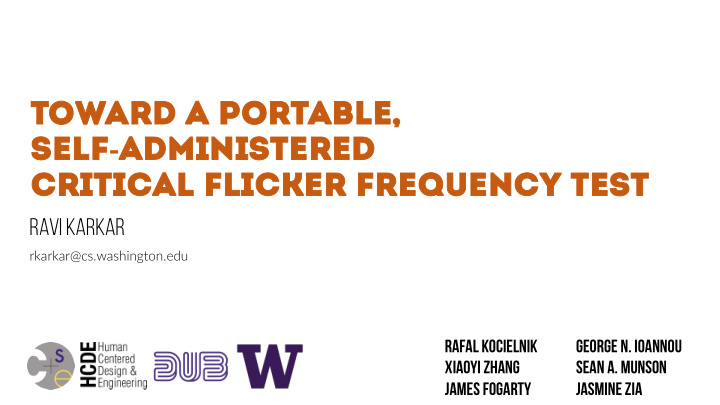



To Toward a Portable, Self - Ad Sel Adminis ministered Cr Critical ical Fl Flicker r Fre Freque uency y Te Test Ravi Karkar rkarkar@cs.washington.edu Rafal Kocielnik George N. Ioannou Xiaoyi Zhang Sean A. munson James Fogarty Jasmine zia
Hepatic Encephalopathy (H.E.) Occurs in people with end-stage liver disease Normal function of liver impaired Toxins build up in the blood (e.g., ammonia) Increased concentration of toxins affects cognitive abilities Ravi Karkar | MHSI @ UBICOMP 2016 2
West Haven Criteria for Hepatic Encephalopathy Stage Level of Intellect & Behavior Neurological Findings Consciousness 0 Normal Normal Normal examination; if impaired psychomotor testing, then MHE 1 Mild Lack of Shortened attention span; Possible mild asterixis or tremor Awareness impaired addition or subtraction 2 Lethargic Disoriented; inappropriate Obvious asterixis; slurred speech 3 Somnolent but Gross disorientation; Muscular rigidity & clonus; arousable bizarre behavior hyper-reflexia 4 Coma Coma Decerebrate posturing Ravi Karkar | MHSI @ UBICOMP 2016 3
Impact of Late Detection of H.E. Reduced quality of life and affects everyday tasks Increased risk of road traffic incidents Increased hospitalizations Increased mortality Ravi Karkar | MHSI @ UBICOMP 2016 4
Cost of late Detection If detected early, easily treatable (Stage 0-1) Affordable, effective home medications to clear toxins If detected late, not easily treatable (Stage 2) Requires hospitalization for intravenous and enema medications If detected really late, can be life-threatening (Stage 3-4) Requires intensive care unit with airway protection (e.g., intubation) Ravi Karkar | MHSI @ UBICOMP 2016 5
Progression of H.E. Worsening liver disease First sign of an underlying infection, gastrointestinal bleeding, dehydration, etc. Ravi Karkar | MHSI @ UBICOMP 2016 6
Current Early diagnostic practices Ravi Karkar | MHSI @ UBICOMP 2016 7
Problem space Early detection Looking for small effects Missing baseline measurement Needs more frequent monitoring We want to reframe as self-tracking instead of a clinical test Treatment effective but can be objectionable Ravi Karkar | MHSI @ UBICOMP 2016 8
Critical flicker frequency Neuro-physiological phenomena Measures the ability of the central nervous system to detect flickering light Is directly influenced by cortical activity Ravi Karkar | MHSI @ UBICOMP 2016 9
Critical flicker frequency 20 Hz 60 Hz ~40 Hz Healthy adults Ravi Karkar | MHSI @ UBICOMP 2016 10
CFF as an early indicator Moderate sensitivity (correctly identify those wi ase ) of 61% with the di diseas Good specificity (correctly identify those withou out the disease ) of 79% Effective in discriminating patients with MHE from those without MHE (screening). Ravi Karkar | MHSI @ UBICOMP 2016 11
design goals Make the device portable Reduce device cost / Enable easy replication Enable self-administration Improve threshold detection algorithm Ravi Karkar | MHSI @ UBICOMP 2016 12
App only design Limited by API access and hardware capabilities LED flash as the light source Phone display as the light source Ravi Karkar | MHSI @ UBICOMP 2016 13
Peripheral based design First step, get the hardware working Ravi Karkar | MHSI @ UBICOMP 2016 14
Viewing box design Ravi Karkar | MHSI @ UBICOMP 2016 15
Peripheral based design First step, get the hardware working Next step, miniaturize the set up Ravi Karkar | MHSI @ UBICOMP 2016 16
Handheld design Ravi Karkar | MHSI @ UBICOMP 2016 17
Next steps Step 1: Device Performance and Accuracy Testing Comparison to the reference device Impact of different test conditions (hopefully relaxing the test constraints) Step 2: Usability Testing Understandability of the device operation Ability to self-administer the test by users Step 3: Feasibility of Lifestyle Integration Understanding everyday challenges in applying the test Ravi Karkar | MHSI @ UBICOMP 2016 18
Other applications for CFF Detect a broad spectrum of neuro-psychological abnormalities visual signal processing (retinal gliopathy) cognitive functions Applied to the study of several neurological disorders multiple sclerosis Alzheimer’s disease CFF is particularly apt for the study of alterations in visual signal processing, and is also suitable for the detection of arousal or attention abnormalities. 19 Ravi Karkar | MHSI @ UBICOMP 2016
Discussion Design priorities viewing conditions reaction time motor impairment identifying distractions Designing for long-term self-monitoring frequency of measures Ravi Karkar | MHSI @ UBICOMP 2016 20
Discussion Communicating results and ethical issues therein patients disbelieve or lie about results show / hide results from patients provide instructions based on result communicate uncertainty share with provider Ravi Karkar | MHSI @ UBICOMP 2016 21
Computer Science & Engineering Ravi Karkar Xiaoyi Zhang James Fogarty Human Centered UW Design & Engineering Medicine Sean Munson Rafal Kocielnik Jasmine Zia George Ioannou Ravi Karkar | MHSI @ UBICOMP 2016 22
Thank you! Discussion: Design priorities Designing for long-term self-monitoring Communicating results and ethical issues therein Ravi Karkar ravikarkar.com rkarkar@cs.washington.edu Ravi Karkar | MHSI @ UBICOMP 2016 23
Recommend
More recommend